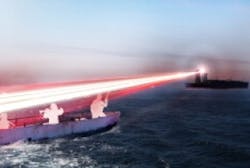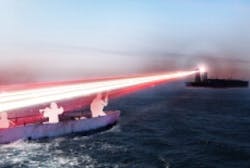Non-lethal laser to defend against pirate attacks developed by BAE Systems
Posted by John McHale
"Laser distraction is part of a wider program of anti-piracy technologies being developed by BAE Systems, including radar systems, which utilizes expertise and knowledge from the military domain," says Bryan Hore, BAE Systems business development manager and the lead for the anti-piracy program. "The aim of the laser distraction project is now to develop a non-lethal deterrent to pirates, which has no lasting effects, which can work in a maritime environment, be operated by the crew at no risk, and be cost effective."Leveraging the capability of its Optics and Laser Technology department within its Advanced Technology Centre, BAE Systems researchers conducted a number of experiments to assess the feasibility of laser distraction as a non-lethal weapon. The research team has now demonstrated a suitable laser at the Pershore Trials Range in Worcester, England over a variety of distances in a variety of conditions.
"Laser distraction is part of a wider program of anti-piracy technologies being developed by BAE Systems, including radar systems, which utilizes expertise and knowledge from the military domain," says Bryan Hore, BAE Systems business development manager and the lead for the anti-piracy program. "The aim of the laser distraction project is now to develop a non-lethal deterrent to pirates, which has no lasting effects, which can work in a maritime environment, be operated by the crew at no risk, and be cost effective."Leveraging the capability of its Optics and Laser Technology department within its Advanced Technology Centre, BAE Systems researchers conducted a number of experiments to assess the feasibility of laser distraction as a non-lethal weapon. The research team has now demonstrated a suitable laser at the Pershore Trials Range in Worcester, England over a variety of distances in a variety of conditions.

